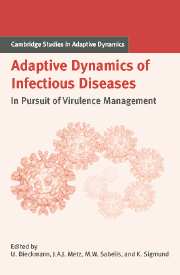Book contents
- Frontmatter
- Contents
- Contributing Authors
- List of Boxes
- Notational Standards
- 1 Introduction
- A Setting the Stage
- Introduction to Part A
- 2 Alternative Transmission Modes and the Evolution of Virulence
- 3 Wildlife Perspectives on the Evolution of Virulence
- 4 Adaptive Dynamics of Pathogen–Host Interactions
- 5 Dilemmas in Virulence Management
- B Host Population Structure
- C Within-Host Interactions
- D Pathogen–Host Coevolution
- E Multilevel Selection
- F Vaccines and Drugs
- G Perspectives for Virulence Management
- References
- Index
- International Institute for Applied Systems Analysis
5 - Dilemmas in Virulence Management
Published online by Cambridge University Press: 15 January 2010
- Frontmatter
- Contents
- Contributing Authors
- List of Boxes
- Notational Standards
- 1 Introduction
- A Setting the Stage
- Introduction to Part A
- 2 Alternative Transmission Modes and the Evolution of Virulence
- 3 Wildlife Perspectives on the Evolution of Virulence
- 4 Adaptive Dynamics of Pathogen–Host Interactions
- 5 Dilemmas in Virulence Management
- B Host Population Structure
- C Within-Host Interactions
- D Pathogen–Host Coevolution
- E Multilevel Selection
- F Vaccines and Drugs
- G Perspectives for Virulence Management
- References
- Index
- International Institute for Applied Systems Analysis
Summary
Introduction
Both the patient who is infected with a communicable disease and the doctor treating the patient share a common interest: the eradication of the infection. That the treatment chosen by the doctor may have detrimental consequences for the population at large is not the primary concern of the doctor or the patient. Such matters are the concern of the larger-scale medical and political organizations that deal with the development of public health policies such as vaccination programs and possibly, as investigated in this book, “virulence management” strategies. Development of such policies is not only a complicated issue because of the intricacies of host–parasite interactions themselves, but also because the common aims of the public health authority and the population do not always overlap very well (Anderson et al. 1997). Of course, the community benefits when an individual ceases to be infective. However, parasites are not inert players in the game, and will adapt to any measures that are taken on a sufficiently large scale. Therefore, the development of some public health policies may not be beneficial to the community as a whole. The global resurgence of tuberculosis (TB) and the fact that many malaria parasites have become resistant against most preventive treatments are just two examples of the detrimental consequences of the large-scale application of individually beneficial medical treatment. The insight that strategies to fight parasites should be based not only on shortterm effects, but also on evolutionary considerations, is gaining ground (Ewald 1993, 1994a).
- Type
- Chapter
- Information
- Adaptive Dynamics of Infectious DiseasesIn Pursuit of Virulence Management, pp. 60 - 70Publisher: Cambridge University PressPrint publication year: 2002
- 8
- Cited by



